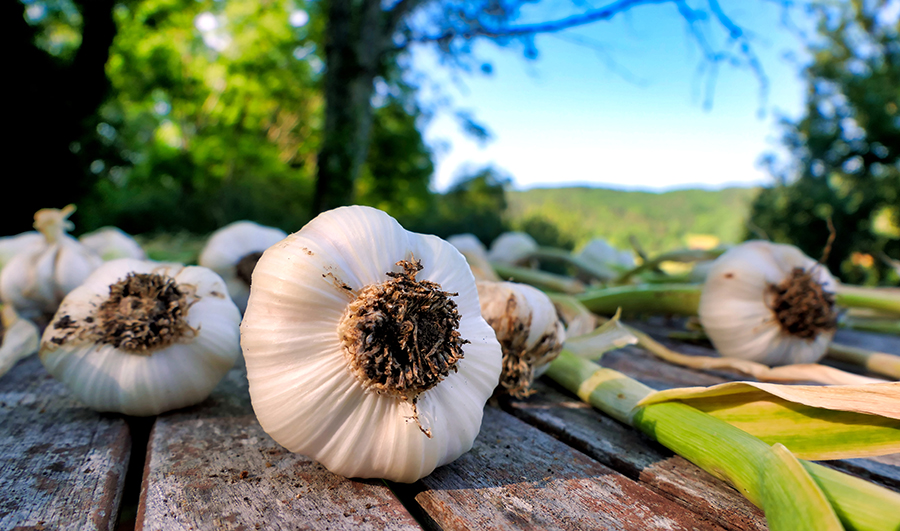Bulbs And Belonging

Un texte de Sarah Cobb
Paru dans le numéro Automne/Fall 2022
Publié le : 9 août 2022
Dernière mise à jour : 11 août 2022
Not unlike plants, people’s genes have altered to facilitate adaptation to their environment long before humans first settled into agrarian communities.
I pulled my garlic today and they are the biggest, whitest bulbs I’ve ever seen. After every year’s harvest, I hang the bulbs in the barn for a couple of weeks to dry out a bit to toughen up the skin. And then I do a little triage. The fattest, juiciest bulbs with at least five cloves get put aside for seeding this autumn. And anything smaller goes into a brown paper bag for eating. If I’m very lucky, the bag lasts until the next year’s crop.
Sometime this fall — invariably on the crappiest, coldest, wettest day when the sky looks like it will open up and rain or snow at any moment–I’ll split the bulbs up into cloves and jam them back into the soft earth. There is no doubt that survival of the fittest makes all the difference when it comes to garlic. The cloves, essentially clones of the parent plant, that flourished in my particular soil will continue to flourish here. While the strains that struggle are relegated to my plate. After ten years of careful selection, my garden rewards me with bigger bulbs every year. And I, in turn, reward my garden with compost and mulch and care. Perhaps my garlic is thinking it has trained its gardener very well.
Soil
It is, after all, one of the planet’s earliest farmed plants, dating back over 5000 years. I thought, as I unceremoniously yanked the bulbs from the ground, just how much time I have invested in my garden over the years. I can’t even imagine how attached I’d feel if I were tending the garden my mother had tended. Or that of her mother’s before her. My sense of belonging and of feeling like the caretaker of the land gets stronger with every hour I spend improving it. It occurred to me today how so many people are no longer able to live on the land their ancestors worked. The first peoples of so many nations and those millions more recently displaced by conflict or environmental disasters that render the land unfit for life.
My neighbour, Charles, is a tree guru who has vast knowledge about the indigenous plants of Quebec. While I go to the garden centre and pick out something because it’s pretty, he spends his time analyzing the soil and choosing which species will thrive before opting what to plant. If you plant a tree in soil that it is unsuited to, a years-long sustained effort to nourish it and ease the transition is essential.
Adaptation
Not unlike plants, people’s genes have altered to facilitate adaptation to their environment since long before humans first settled into agrarian communities. Certain populations developed the ability to digest cow’s milk while others evolved a natural resistance to malaria. The Bajau people, who freedive in the seas of Southeast Asia, developed massive spleens which allow them to hold their breath for thirteen minutes. 87% of Tibetans possess a genetic mutation that allows their bodies to function with very little oxygen. Natural selection has given humans a leg up in dealing with their environment in every corner of the globe. But these are not adaptations that happened overnight.
How much more brutal to extract someone from their ancestral home when their very bodies are attuned to it. It doesn’t seem reasonable to expect a recent immigrant to instantly adapt to a new culture and environment. Especially for those who’ve experienced trauma before finding their way here. Isn’t it crazy that we acknowledge that it may take a plant several generations to properly adapt to its new surroundings, never mind flourish, while a refugee gets six months to find a home, find a school, find a job, find a new life. Is it any wonder integration isn’t as seamless as our politicians would like it to be?
Sarah Cobb

